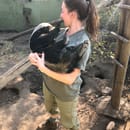Walking with both eyes open: A look into the use and possible effectiveness of camera trapping
By Emily DeAlto, Julia Gardner, Max Mittelstaedt, and GuruBandaa Khalsa
On what seems to be one of our last days in Australia due to the worldwide COVID-19 panic, we’re taking a walk around Lake Eacham in QLD, observing the bit of wildlife that braves showing itself to us: some small birds, a few skinks, a musky rat kangaroo. Though we’re glad to have seen what we saw on this walk, we wonder what creatures may be scurrying around out of our eyesight and our bumbling steps…
Reliable methods of evaluating animal populations have long evaded wildlife ecologists. Camera traps are a tried solution to combat man’s tendency to apathetically disturb the target fauna they are so keen to study. Camera traps are camouflaged cameras in target study areas that take photos when triggered by movement. They were originally implemented to study larger exotic species with easily identifiable individuals such as lions and tigers and bears (OH MY!). Their use, however, has spread into the observation of more commonplace fauna. Researchers and conservationists worldwide use camera traps to assess target populations or individuals. However, analysis of their effectiveness in capturing desired data is lacking.
In this investigation, we wanted to see if the wildlife we observed with our five senses matched up with camera trap findings around the Lake Eacham and Chambers Wildlife Lodge trails. We took two sample hikes of each path, once in the morning at 9am and once in the afternoon at 2pm, with our eyes peeled for wildlife and our pens ready to record. This survey was done in March 2020, and comparative data was taken from results of camera trap surveys done in the same areas in March 2020 and October 2019.
Once we had our data recorded, we were ready to compare it to the results of the camera traps. We had hypothesized that the silent nature of the camera traps would allow for a more diverse catalogue of fauna observed, but the results were quite different. When compared to the camera trap data from 2019 and 2020, there were far fewer species as well as fewer individuals seen by the camera traps than in our survey hikes. Upon analysis, it seems that we were much better able to see small critters like slippery skinks and hastily fluttering birds. We also observed slightly more musky rat kangaroos than the camera traps: nine versus six. It seems that generally, the naked eye is better able to effectively gather data, despite the usual assumption that animals are less likely to reveal themselves to humans due to natural instincts. Perhaps the fact that man is mobile while collecting data contributes to a higher effectiveness in study. Camera traps are also less adept at sampling smaller fauna such as reptiles and small birds than the naked eye. We were able to easily observe organisms such as skinks, water dragons, and robins on our walks, while the traps caught none of these.
In a technological revolution, it is easy to assume that newer automation will lead to more precise and higher quality results, however it is critical to study the true effectiveness of these methods in all scenarios. While a camera trap may be the best choice when attempting to observe large shy beasties that will rarely approach humans, such as the pademelons and scrub fowls seen by the traps in this study, one cannot assume that this method will work across ecosystems. Further study is crucial to truly understand the best application of this technology. Good science is done only with numerous trials and reviews of these trials. Although seemingly tedious, studies like this can hopefully shed light on the growing field of camera trapping for future use.



